This month’s National Love a Tree Day got us thinking about the value of trees in our own yards and those we grow at Loma Vista Nursery. Trees are stately, flowering, artful, reaching, flowing and fruit, berry or nut producing. Some are tall, some are short and some are midsize. Trees are home to birds and small animals and are a source of shelter for human beings, too. Trees offer us so much, but they do much, much more than provide us with shelter, shade and beauty.
They mitigate the impacts of climate change.
Carbon dioxide is an atmospheric “greenhouse gas” that hovers over the Earth like a dome. The more CO2 there is, the more heat that’s trapped above us, causing Earth’s temperatures to rise. Trees absorb carbon dioxide from the air through their leaves – and the bigger the tree, the more CO2 they absorb. And the more carbon dioxide trees absorb, the less there is of it in the atmosphere.
Along with water pulled up from plants’ roots, the sun turns the absorbed carbon dioxide into sugar and stores it in the plant’s tissues. Sugar, water and soil nutrients are processed for food, which produces energy that keeps plants healthy and nourishes new growth. Once this cycle is complete, trees and other green plants then release oxygen back into the air.
So, the upshot: plant more trees. Here are a few we are shipping out from our dock this spring.
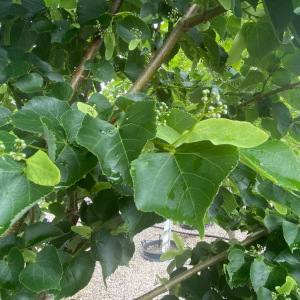
Little-Leaf Linden (Tilia cordata ‘Greenspire’)
Greenspire Linden
Greenspire Linden is a quintessential favorite in urban settings for its tolerance of pollution, neighboring pavements and dry environmental conditions. It is resistant to frost and withstands winds. Uniformly growing, it has a straight, dark brown and grooved trunk. Linden’s crown begins with a pyramidal shape, then transitions to oval and matures half-open. At 30 to 40 feet tall and 15 to 30 feet wide at maturity, it is actually a bit smaller than other varieties. Foliage is heart-shaped and tapers to a distinct point at the tip of each leaf. Greenspire Linden attracts bees and butterflies. Plant in full sun, in USDA Hardiness Zone 4.
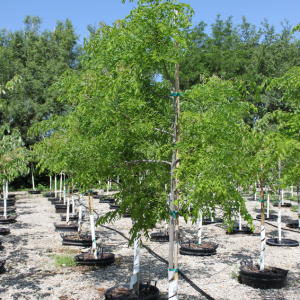
Espresso™ Kentucky Coffee Tree (Gymnocladus dioicus ‘Espresso’)
Espresso Coffee Tree
Large green leaves filter sun and provide shade for sipping your morning coffee at a bistro table under its arching branches! Espresso coffee tree is a seedless cultivar with a vase-like shape at maturity, rising 60 to 75 feet tall and spreading 40 to 50 feet wide. It tolerates alkaline soils, drought, road salt and pollution. Espresso coffee tree is a versatile, moisture-conserving tree in the landscape. White fragrant flowers bloom as leaves mature in late spring and early summer. Site in partial to full sun. Plant in USDA Hardiness Zone 4.
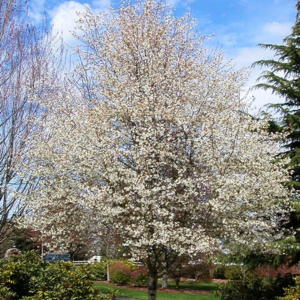
Spring Flurry Serviceberry (Amelanchier laevis ‘JFS-Arb’)
Spring Flurry® Serviceberry
A spring-time delight! Spring Flurry® Serviceberry puts on a stunning show in spring. Clusters of bright-white flowers blanket its branches before leaves emerge. Later on, the show continues with bright orange foliage in fall. This serviceberry matures to 25 feet tall and spreads 20 feet, making it a perfect street tree and specimen selection for smaller landscapes. A low maintenance tree, birds like it for its bluish berries in late spring. Plant in partial shade to full sun. Grows best in USDA Hardiness Zone 4.
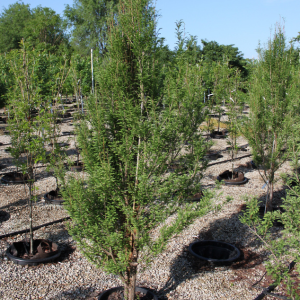
Lindsey’s Skyward™ Baldcypress (Taxodium distichum ‘Skyward’)
Lindsey’s Skyward Baldcypress
Looks are deceiving! Lindsey’s Skyward Baldcypress may look prickly, but it’s as soft as cashmere. This deciduous tree has a narrow, columnar form and is a good selection for smaller landscapes. Height is 18 to 20 feet and its spread is 5 to 6 feet. This tree works especially well as a privacy screen and as a loose hedge when planted two or more side-by-side. Foliage is deep green in spring and summer. Leaves turn copper in fall before dropping to reveal textured, bronze-colored bark. Roots are fibrous and won’t upset sidewalks, driveways and other paved surfaces. Lindsey’s Skyward Baldcypress likes well-drained soil and is drought tolerant once established. Plant in full sun, in USDA Hardiness Zones 5 to 9.
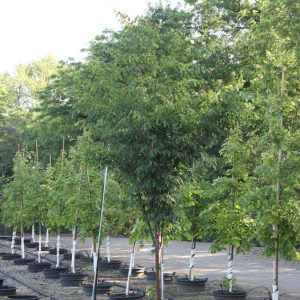
Musashino Zelkova (Zelkova serrata ‘Musashino’)
Zelkova
Musashino Zelkova likes city living and is the right tree for challenging areas and small spaces requiring shade. Native to Japan, Korea and Taiwan, its columnar shape has tightly packed, upright green branches that gracefully bend at the tree’s upper half. Foliage turns yellow to rust-orange in the fall. Virtually maintenance free, Zelkova doesn’t mind road salt and likes soil that is evenly moist. It towers 40 to 45 feet tall and spreads 12 to 15 feet at maturity. Plant in full sun, in USDA Hardiness Zones 5 to 9.
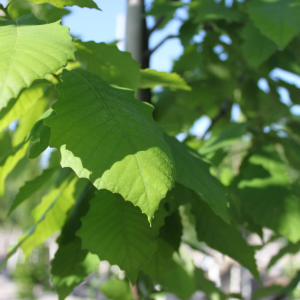
Quercus muehlenbergii (Chinkapin Oak)
Chinkapin Oak
Native to North America, Chinkapin Oak performs well in alkaline soils containing stubborn clay. But it also grows nicely in soils that are acidic, sandy, loamy and typically wet. Select this tree for parks, playgrounds and larger residential areas. Although it’s a slow grower, height at maturity is 50 to 80 feet. Spread is 50 to 70 feet. Leaves are small and yellow-green with a glossy sheen and toothed edges. Bark is pale gray and ridged. Chinkapin Oak starts out with a pyramidal habit that becomes rounder at maturity. It tolerates dry sites and moderate drought. Migrant birds and small mammals enjoy resting in this deciduous tree. Site Chinkapin Oak in full sun. Grows well in USDA Hardiness Zones 5 to 7.
Learn About Landscape Plants from Loma Vista Nursery
Loma Vista Nursery’s staff members are experts in the field. We love helping people learn and understand more about plants. Visit our plant catalog for information about trees, shrubs and perennial plants that are ideal for Midwest landscapes. To get answers to plant-related questions, send an email to sales@lomavistanursery.com or call (785) 229-7200.
Connect With Us
Stay current on our plant recommendations, growing tips and more by following us on social media.
